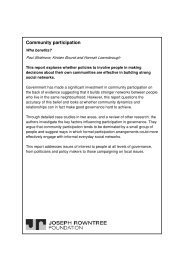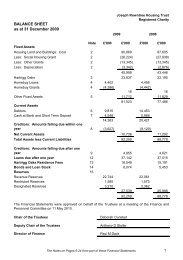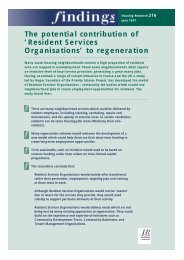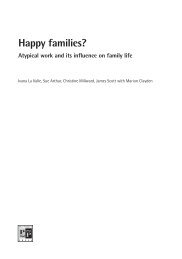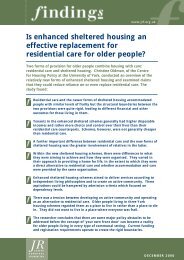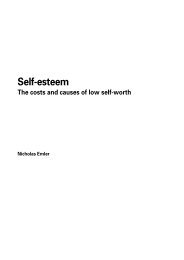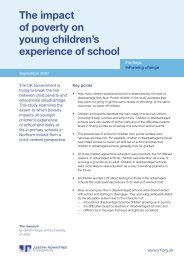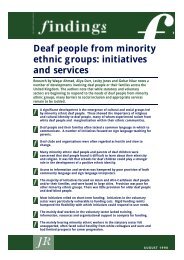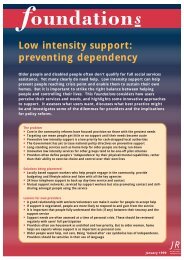Summary PDF 4 pages 0.1 MB - Joseph Rowntree Foundation
Summary PDF 4 pages 0.1 MB - Joseph Rowntree Foundation
Summary PDF 4 pages 0.1 MB - Joseph Rowntree Foundation
Create successful ePaper yourself
Turn your PDF publications into a flip-book with our unique Google optimized e-Paper software.
and commitment to be involved in local governance<br />
is currently small. Participation is restricted to a small<br />
minority.<br />
Participation in the public domain<br />
Faith communities also contribute to social capital through<br />
participation in the wider public domain, less directly<br />
influenced by government. Many faith communities are<br />
internally diverse in terms of age, gender, occupational<br />
class, ethnicity and, increasingly, language. This can be a<br />
source of conflict, division or repression. But it can also<br />
challenge people to move beyond bonding to address the<br />
demands of bridging.<br />
However, faith communities are often not participative,<br />
and their leaders and members are not always<br />
organisationally aware and adept. Leaders who facilitate<br />
the involvement and development of community members<br />
are of key importance. Their selection, training and<br />
example are of major significance in equipping members.<br />
The research found promising examples of organisational<br />
and congregational programmes that were developing<br />
members to participate both within and beyond their faith<br />
community. Training and activity which are shared with<br />
other groups are valuable in reducing misunderstandings<br />
between faith and secular groups and inequalities of<br />
capacity among faith groups.<br />
As with many non-faith contexts, external networking and<br />
action are usually undertaken by a relatively small number<br />
of faith-group members, but their achievements are often<br />
substantial. Relations between an externally networking<br />
minority and their home congregations and communities<br />
are variable. Sometimes the activism of the former<br />
and the internal preoccupations of the latter produce<br />
a weakening of bonds. In other cases, those working<br />
beyond their starting base may remain strongly integrated,<br />
supported by bonding relationships. In return, they draw<br />
others into the skills and qualities of bridge-building, linkmaking<br />
and strengthening the community and its capacity<br />
to look outwards.<br />
About the project<br />
The research was designed to achieve rigorous analysis<br />
of a limited number of potentially instructive cases with<br />
both positive and negative potential for social capital. The<br />
focus was on particular places and episodes involving,<br />
variously, Christian, Hindu, Jewish, Muslim, Sikh and nonfaith<br />
people and organisations. The cases and episodes<br />
were concentrated in London, the West Midlands, the<br />
North West and Yorkshire in localities characterised by<br />
ethnic and religious diversity.<br />
The core research group comprised Robert Furbey<br />
(lecturer in urban sociology, Sheffield Hallam University),<br />
Adam Dinham (lecturer in social policy, Anglia<br />
Ruskin University) and Richard Farnell (Professor of<br />
Neighbourhood Regeneration, Coventry University). The<br />
primary research was informed by a series of activity<br />
field reviews undertaken by consultant members of the<br />
research group with expertise in specific fields: Doreen<br />
Finneron (faith buildings); Catherine Howarth (community<br />
organising); Dilwar Hussain and Guy Wilkinson (inter-faith<br />
relations); and Sharon Palmer (governance). The main<br />
research technique was the semi-structured interview (24<br />
people). Documentary evidence was also used, and the<br />
study incorporated an element of observation (sometimes<br />
extending to participation). Interviews were conducted<br />
with people who were seen as leaders, including both<br />
clergy and laity. Activists, users and other informal<br />
participants were also interviewed. Interviewees were<br />
selected to achieve cross-checking of experiences and<br />
interpretations. There were also nine group interviews,<br />
involving a total of 31 participants from 25 organisations.<br />
For further information<br />
The full report, Faith as social capital: Connecting or dividing? by Robert Furbey, Adam Dinham, Richard Farnell,<br />
Doreen Finneron and Guy Wilkinson with Catherine Howarth, Dilwar Hussain and Sharon Palmer, is published for the<br />
<strong>Foundation</strong> by The Policy Press (ISBN 1 86134 837 1, price £12.95).<br />
Published by the <strong>Joseph</strong> <strong>Rowntree</strong> <strong>Foundation</strong>, The Homestead,<br />
40 Water End, York YO30 6WP. This project is part of the JRF's research<br />
and development programme. These findings, however, are those of the<br />
authors and not necessarily those of the <strong>Foundation</strong>. ISSN 0958-3084<br />
Read more Findings at www.jrf.org.uk<br />
Other formats available.<br />
Tel: 01904 615905, Email: info@jrf.org.uk<br />
Ref: 0136



